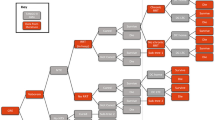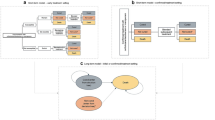Abstract
This study compared the cost-effectiveness of meropenem with that of imipenem plus cilastatin in the treatment of severe infections in hospital intensive care in the UK. A Markov model was constructed to model lifetime costs and quality-adjusted life years (QALYs) of using meropenem and imipenem plus cilastatin for the treatment of severe infections in intensive care. Estimates of effectiveness, utility weights and costs were obtained from the published literature. Probabilistic sensitivity analysis was conducted to assess the robustness of the results. Estimated treatment costs for the patient cohort were £14,938 with meropenem and £15,585 with imipenem plus cilastatin. QALYs gained were 7,495 with meropenem and 7,413 with imipenem plus cilastatin. Probabilistic sensitivity analysis showed meropenem to be significantly less costly (−£636.47, 95% CI −£132.33 to–£1,140.62) and more effective (0.084, 95% CI 0.023 to 0.144). Meropenem thus appears significantly more effective and less expensive than imipenem plus cilastatin and should therefore be considered the dominant treatment strategy.


Similar content being viewed by others
References
Edwards SJ, Emmas CE, Campbell HE (2005) Systematic review comparing meropenem with imipenem plus cilastatin in the treatment of severe infections. Curr Med Res Opin 21:785–794
Wright JC, Plenderleith L, Ridley SA (2000) Long-term survival following intensive care: subgroup analysis and comparison with the general population. Anaesthesia 58:637–642
Garau J, Blanquer J, Cobo L, Corcia S, Daguerre M, de Latorre FJ, Leon C, Del Nogal F, Net A, Rello J (1997) Prospective, randomised, multicentre study of meropenem versus imipenem/cilastatin as empiric monotherapy in severe nosocomial infections. Eur J Clin Microbiol Infect Dis 16:789–796
Rosenberg AL, Watts C (2000) Patients readmitted to ICUs: a systematic review of risk factors and outcomes. Chest 118:492–502
Anonymous (1999) National statistics. Mortality statistics: England and Wales 1999. TSO: London
Anonymous (2004) National statistics. Annual abstract of statistics 2004. TSO: London
Anonymous (2004) NHS reference costs 2003 and national tariff 2004. Payment by results. Core tools. Available at: http://www.dh.gov.uk/PublicationsAndStatistics/Publications/PublicationsPolicyAndGuidan ce/PublicationsPolicyAndGuidanceArticle/fs/en?CONTENT_ID=4070195&chk=UzhHA3
Anonymous (2003) British national formulary. British Medical Association and Royal Pharmaceutical Society of Great Britain: London
Kerridge RK, Glasziou PP, Hillman KM (1995) The use of “quality-adjusted life years” (QALYs) to evaluate treatment in intensive care. Anaesth Intensive Care 23:322–331
National Institute for Clinical Excellence (2004) Technology appraisals process: guide to the methods of technology appraisal. Available at:http://www.nice.org.uk/page.aspx?o=201973
Briggs AH, Goeree R, Blackhouse G, O’Brien BJ (2002) Probabilistic analysis of cost-effectiveness models: choosing between treatment strategies for gastroesophageal reflux disease. Med Decis Making 22:290–308
Rawlins MD, Culyer AJ (2004) National Institute for Clinical Excellence and its value judgments. BMJ 329:224–227
Smyth ETM, Barr JG, Hogg GM (1996) An assessment of hidden costs on total prescribing costs of courses of meropenem and imipenem/cilastatin. Br J Med Econ 10:325–340
Plumridge RJ (1997) Cost analysis of infusion versus injection delivery of imipenem/cilastatin and meropenem. Clin Drug Invest 14:132–136
Attanasio E, Russo P, Carunchio G, Basoli A, Caprino L (2000) Cost-effectiveness study of imipenem/cilastatin versus meropenem in intra-abdominal infections. Dig Surg 17:164–172
Basoli A, Meli EZ, Mazzocchi P, Speranza V (1997) Imipenem/cilastatin (1.5 mg daily) versus meropenem (3 g daily) in patients with intra-abdominal infections: results of a prospective, randomised, multicentre trial. Scand J Infect Dis 29:503–508
Acknowledgements
The authors thank the following for helping develop the treatment algorithm and sense check the data used in the model: Dr. Stephen Dean (Clinical Director, St James’ University Hospital), Dr. Jeremy Sizer (Consultant Anaesthetist, Bedford Hospital), Dr. Christopher Garrard (Medical Director, John Radcliffe Hospital), and Dr. Richard Marsh, (Consultant Anaesthetist and& Lead Clinician for Critical Care, Northampton General Infirmary).
Conflict of interest:
No information supplied
Author information
Authors and Affiliations
Corresponding author
Rights and permissions
About this article
Cite this article
Edwards, S.J., Campbell, H.E. & Plumb, J.M. Cost-utility analysis comparing meropenem with imipenem plus cilastatin in the treatment of severe infections in intensive care. Eur J Health Econ 7, 72–78 (2006). https://doi.org/10.1007/s10198-005-0333-y
Issue Date:
DOI: https://doi.org/10.1007/s10198-005-0333-y




